Essential Japanese Words and Phrases for Beginners

Written by
Ernest Bio Bogore

Reviewed by
Ibrahim Litinine

Are you planning a trip to Japan or interested in Japanese culture? Learning some basic Japanese words and phrases can significantly enhance your experience and show respect for the local culture. This comprehensive guide covers hundreds of essential Japanese expressions to kickstart your language journey.
So, what are you waiting for? Yatte miyo (Let's try)!
What are some essential Japanese words and phrases for beginners?
Essential Japanese words and phrases for beginners include fundamental greetings like 'Konnichiwa' (Hello) and 'Arigatou' (Thank you), as well as practical expressions such as 'Sumimasen' (Excuse me/I'm sorry) and 'Hai' (Yes). Mastering these basic expressions forms the foundation for effective everyday communication in Japanese and serves as an excellent starting point for language learners.
Key Japanese Phrases for Everyday Communication
Having a repertoire of basic Japanese sentences is invaluable, especially when venturing beyond tourist areas. Here are some essential expressions to help you navigate daily interactions:
- Hai (はい): Yes
- Iie (いいえ): No
- Namae wa nan desu ka (名前はなんですか): What is your name?
- Watashi wa ~ desu (私は〜です): I am ~
- ~kara kimashita (
から来ました): I came from/I am from~ - Kore wa nan desu ka (これは何ですか): What is this?
- Ikura desu ka (いくらですか): How much?
- Kore kudasai (これください): Can I get this one?/I will take this one
- Onegaishimasu (おねがいします): Please
- Chumon onegaishimasu (注文お願いします): Can I place an order?
- Mizu o onegaishimasu (水をお願いします): Water please
- Okaikei onegaishimasu (お会計お願いします): Can I get the bill, please?
- Koko wa doko desu ka (ここはどこですか): Where am I?
- Toire wa doko desu ka (トイレはどこですか): Where is the bathroom?
- Eki wa doko desu ka (駅はどこですか): Where is the train station?
- Ima nan ji desu ka (今何時ですか): What time is it now?
- Wakarimasen (わかりません): I don't understand
- Nihongo o hanasemasen (日本語を話せません): I can't speak Japanese
- Eigo o hanasemasu ka (英語を話せますか): Do you speak English?
- Tasukete kudasai (助けてください): Please help me
Essential Japanese Greetings
In Japanese culture, greetings are accompanied by bowing, which demonstrates respect, gratitude, and consideration. Learning the appropriate Japanese expressions to accompany a bow is crucial for cultural integration.
- Ohayou gozaimasu (おはようございます): Good morning Used only before 11 am. For casual situations, simply say "Ohayou" without the formal "gozaimasu."
- Konnichiwa (こんにちは): Good afternoon Often misinterpreted as "Hello," this phrase specifically means "Good afternoon" and should only be used during daytime hours.
- Konbanwa (こんばんは): Good evening Used from late afternoon (around 5 pm) into the evening.
- Arigatou gozaimasu (ありがとうございます): Thank you For casual situations, simply "Arigatou" is sufficient.
- Sumimasen (すみません): Excuse me/I'm sorry This versatile expression works in multiple contexts—getting a waiter's attention, asking for help when lost, or apologizing formally.
- Sayonara (さようなら): Goodbye Used for longer partings; not for casual "see you later" situations.
- Mata ne (またね): See you later A casual way to say goodbye when you expect to see the person again soon.
- Otsukaresama desu (お疲れ様です): Good work/Thank you for your effort Commonly used in workplace settings to acknowledge someone's hard work.
People and Pronouns in Japanese
One of the most distinctive aspects of Japanese communication is how speakers use pronouns. Unlike English and many other languages, Japanese often avoids pronouns entirely in conversations where the subject is already clear.
Instead of saying "you," "he," or "she," Japanese speakers typically use the person's name, family role, or social position. This practice reflects the cultural emphasis on context and relationships rather than direct reference.
- Watashi/Boku/Ore (私、僕、俺): I "Watashi" is generally neutral, "Boku" is used by males (casual), and "Ore" is very casual and masculine.
- Tomodachi (友達): Friend
- Dooryoo (同僚): Co-worker
- Buchoo/Shachoo (部長、社長): Boss/President (of a company)
- Kazoku (家族): Family
- Otoo-san (お父さん): Father
- Okaa-san (お母さん): Mother
- Onii-san (お兄さん): Older brother
- Onee-san (お姉さん): Older sister
- Otooto (弟): Younger brother
- Imooto (妹): Younger sister
- Otona (大人): Adults
- Kodomo (子供): Children
- Kareshi (彼氏): Boyfriend
- Kanojo (彼女): Girlfriend
- Otoko no hito (男の人): Man
- Onna no hito (女の人): Woman
- Sensei (先生): Teacher/Doctor/Professional
- Gakusei (学生): Student
Japanese Food and Drink Vocabulary
Japan's culinary culture is world-renowned, with Tokyo holding more Michelin stars than any other city globally. Japanese cuisine encompasses both traditional washoku (和食) and yoshoku (洋食), which incorporates Western influences. Here are essential food and drink terms to enhance your dining experience:
- Asa-gohan (朝ご飯): Breakfast
- Hiru-gohan (昼ご飯): Lunch
- Yoru-gohan (夜ご飯): Dinner
- Gohan (ご飯): Rice/Meal
- Pan (パン): Bread
- Niku (肉): Meat
- Sakana (魚): Fish
- Yasai (野菜): Vegetables
- Kudamono (果物): Fruits
- Suupu (スープ): Soup
- Sarada (サラダ): Salad
- Tamago (卵): Egg
- Gyuu-nyuu (牛乳): Milk
- Chiizu (チーズ): Cheese
- Dezaato (デザート): Dessert
- Mizu (水): Water
- Ocha (お茶): Green tea/Tea in general
- Koohii (コーヒー): Coffee
- Osake (お酒): Sake/Alcohol in general
- Wain (ワイン): Wine
- Biiru (ビール): Beer
Traditional Japanese Dishes
- Sushi (寿司): Vinegared rice topped with various ingredients, often raw fish
- Ramen (ラーメン): Noodle soup dish
- Tempura (天ぷら): Deep-fried seafood and vegetables
- Udon (うどん): Thick wheat flour noodles
- Soba (そば): Thin buckwheat noodles
- Onigiri (おにぎり): Rice balls wrapped in seaweed
- Miso Soup (味噌汁): Traditional soup made with fermented soybean paste
- Donburi (丼): Rice bowl dish with various toppings
- Okonomiyaki (お好み焼き): Savory pancake with various ingredients
Japanese Numbers (1-100)
The Japanese number system is relatively straightforward and follows logical patterns once you've learned the basics. Here are the numbers from 0 to 100:
- 0: Rei (れい) or Zero (ゼロ)
- 1: Ichi (いち)
- 2: Ni (に)
- 3: San (さん)
- 4: Shi (し) or Yon (よん)
- 5: Go (ご)
- 6: Roku (ろく)
- 7: Shichi (しち) or Nana (なな)
- 8: Hachi (はち)
- 9: Kyuu (きゅう) or Ku (く)
- 10: Juu (じゅう)
Numbers 11-19 follow the pattern of "juu + number":
- 11: Juu-ichi (じゅういち)
- 12: Juu-ni (じゅうに)
- 13: Juu-san (じゅうさん)
- 14: Juu-yon (じゅうよん)
- 15: Juu-go (じゅうご)
For multiples of 10, the pattern is "number + juu":
- 20: Ni-juu (にじゅう)
- 30: San-juu (さんじゅう)
- 40: Yon-juu (よんじゅう)
- 50: Go-juu (ごじゅう)
- 60: Roku-juu (ろくじゅう)
- 70: Nana-juu (ななじゅう)
- 80: Hachi-juu (はちじゅう)
- 90: Kyuu-juu (きゅうじゅう)
- 100: Hyaku (ひゃく)
Understanding these numerical patterns will help you count, tell time, discuss prices, and navigate dates in Japanese.
Japanese Time Expressions
When traveling in Japan, understanding time-related expressions is essential for scheduling, transportation, and daily activities.
Days of the Week
- Sunday: Nichiyoubi (日曜日)
- Monday: Getsuyoubi (月曜日)
- Tuesday: Kayoubi (火曜日)
- Wednesday: Suiyoubi (水曜日)
- Thursday: Mokuyoubi (木曜日)
- Friday: Kinyoubi (金曜日)
- Saturday: Doyoubi (土曜日)
Interesting fact: Each day of the week in Japanese incorporates a character representing an element of nature or astronomy - the sun, moon, fire, water, wood, gold/metal, and earth respectively.
Months of the Year
- January: Ichigatsu (一月)
- February: Nigatsu (二月)
- March: Sangatsu (三月)
- April: Shigatsu (四月)
- May: Gogatsu (五月)
- June: Rokugatsu (六月)
- July: Shichigatsu (七月)
- August: Hachigatsu (八月)
- September: Kugatsu (九月)
- October: Juugatsu (十月)
- November: Juuichigatsu (十一月)
- December: Juunigatsu (十二月)
Other Time References
- Today: Kyou (今日)
- Yesterday: Kinou (昨日)
- Tomorrow: Ashita (明日)
- This week: Konshuu (今週)
- Last week: Senshuu (先週)
- Next week: Raishuu (来週)
- This month: Kongetsu (今月)
- Last month: Sengetsu (先月)
- Next month: Raigetsu (来月)
- This year: Kotoshi (今年)
- Last year: Kyonen (去年)
- Next year: Rainen (来年)
Hours
- 1 o'clock: Ichi-ji (一時)
- 2 o'clock: Ni-ji (二時)
- 3 o'clock: San-ji (三時)
- 4 o'clock: Yon-ji (四時)
- 5 o'clock: Go-ji (五時)
- 6 o'clock: Roku-ji (六時)
- 7 o'clock: Shichi-ji/Nana-ji (七時)
- 8 o'clock: Hachi-ji (八時)
- 9 o'clock: Ku-ji (九時)
- 10 o'clock: Juu-ji (十時)
- 11 o'clock: Juuichi-ji (十一時)
- 12 o'clock: Juuni-ji (十二時)
To specify AM or PM, add "gozen" (午前) for morning hours and "gogo" (午後) for afternoon/evening hours.
Places and Transportation in Japanese
Japan's transportation system is renowned for its efficiency and punctuality. Understanding place-related vocabulary will help you navigate the country's extensive train, subway, bus, and Shinkansen (bullet train) networks.
- Eki (駅): Station
- Byouin (病院): Hospital
- Ryougae (両替): Money Exchange
- Ginkou (銀行): Bank
- Keisatsusho (警察署): Police Station
- Yubinkyoku (郵便局): Post office
- Konbini (コンビニ): Convenience store
- Pan ya (パン屋): Bakery
- Mise (店): Store/Shop
- Suupaa (スーパー): Grocery store
- Kuukou (空港): Airport
- Basu-tei (バス停): Bus stop
- Minato (港): Port
- Jinja (神社): Shrine
- Otera (お寺): Temple
- Machi (町): Town
- Hoteru (ホテル): Hotel
- Uketsuke (受付): Reception
- Kouen (公園): Park
- Toshokan (図書館): Library
- Bijutsukan (美術館): Art museum
- Hakubutsukan (博物館): Museum
- Daigaku (大学): University
- Chikatetsu (地下鉄): Subway
- Shinkansen (新幹線): Bullet train
Japanese Colors
Colors in Japanese are straightforward to learn and can be helpful when shopping, giving directions, or describing objects.
- Aka (赤): Red
- Ao (青): Blue
- Kiiro (黄色): Yellow
- Midori (緑): Green
- Shiro (白): White
- Kuro (黒): Black
- Murasaki (紫): Purple
- Orenji (オレンジ): Orange
- Pinku (ピンク): Pink
- Chairo (茶色): Brown
- Gin-iro (銀色): Silver
- Kin-iro (金色): Gold
- Hai-iro (灰色): Gray
- Mizu-iro (水色): Light blue
- Kon (紺): Navy blue
Interesting cultural note: In Japanese, "ao" traditionally covered both blue and green colors. Modern Japanese distinguishes between them, but you might still hear green traffic lights referred to as "ao".
Essential Japanese Verbs
Understanding basic Japanese verbs is crucial for constructing meaningful sentences. Here are some fundamental verbs in their dictionary (infinitive) form:
- Taberu (食べる): to eat
- Iku (行く): to go
- Nomu (飲む): to drink
- Kiku (聞く): to listen, hear
- Yomu (読む): to read
- Miru (見る): to see, look, watch
- Neru (寝る): to sleep
- Okiru (起きる): to wake up
- Hanasu (話す): to talk, speak
- Kaeru (帰る): to return, go back
- Suwaru (座る): to sit down
- Tatsu (立つ): to stand up
- Oyogu (泳ぐ): to swim
- Asobu (遊ぶ): to play
- Noru (乗る): to ride
- Kau (買う): to buy
- Au (会う): to meet
- Kaku (書く): to write
- Matsu (待つ): to wait
- Toru (撮る): to take a picture
- Shiru (知る): to know
- Wakaru (分かる): to understand
- Tsukuru (作る): to make
- Morau (貰う): to receive
Cultural Etiquette Phrases
Understanding cultural etiquette is as important as learning vocabulary when studying Japanese. These phrases will help you navigate social situations respectfully:
- Itadakimasu (いただきます): Said before eating (expresses gratitude for the food)
- Gochisousama deshita (ごちそうさまでした): Said after finishing a meal (expresses appreciation)
- Yoroshiku onegaishimasu (よろしくお願いします): Please treat me well/Nice to meet you
- Ojama shimasu (お邪魔します): Excuse me for disturbing you (said when entering someone's home)
- Tadaima (ただいま): I'm home (said when returning to your own home)
- Okaeri (おかえり): Welcome back (response to "tadaima")
- Omedetou gozaimasu (おめでとうございます): Congratulations
- Otsukaresama desu (お疲れ様です): Good work/Thank you for your efforts
- Shitsurei shimasu (失礼します): Excuse me (when leaving, interrupting, etc.)
Japanese Words for Travelers
These practical expressions are particularly useful for visitors to Japan:
- Shashin o totte kudasai (写真を撮ってください): Please take a picture
- ~ wa doko desu ka? (~はどこですか): Where is ~?
- Wakarimasu (分かります): I understand
- Daijoubu desu (大丈夫です): It's okay/I'm fine
- Tasukete kudasai (助けてください): Please help me
- Tomare (止まれ): Stop
- Yukkuri onegaishimasu (ゆっくりお願いします): Please speak slowly
- Mou ichido onegaishimasu (もう一度お願いします): Please say that again
- Eigo no menu arimasu ka? (英語のメニューありますか): Do you have an English menu?
- Kore o kudasai (これをください): I'd like this please
- Oishii (美味しい): Delicious
- Wi-Fi pasuwaado wa nan desu ka? (Wi-Fiパスワードは何ですか): What is the Wi-Fi password?
Japanese Dialects and Regional Expressions
While standard Japanese (hyōjungo) is widely understood throughout Japan, regional dialects (hōgen) add richness and variety to the language. Here are a few notable dialects and some of their distinctive expressions:
- Kansai-ben (関西弁): Spoken in the Osaka, Kyoto, and Kobe region
- Ookini (おおきに): Thank you (instead of arigatou)
- Meccha (めっちゃ): Very (instead of totemo)
- Tohoku-ben (東北弁): Spoken in northern Honshu
- Ndabe (んだべ): I wonder (instead of deshou)
- Hakata-ben (博多弁): Spoken in Fukuoka area
- Tadoru (たどる): Tired (instead of tsukareta)
While learning these regional variations isn't essential for beginners, recognizing their existence can enhance your appreciation of Japanese linguistic diversity.
Basic Japanese Grammar Structures
Understanding a few fundamental grammar patterns can help you construct simple but effective sentences:
- Basic sentence structure: Japanese follows a Subject-Object-Verb pattern
- Example: Watashi wa ringo o tabemasu (私はりんごを食べます): I eat an apple
2. Particle usage: Particles mark the grammatical function of words
- wa (は): Topic marker
- o (を): Object marker
- ni (に): Direction/location marker
- de (で): Location of action marker
- ga (が): Subject marker
3. Question formation: Add "ka" (か) at the end of a sentence to form a question
- Statement: Kore wa hon desu (これは本です): This is a book
- Question: Kore wa hon desu ka? (これは本ですか): Is this a book?
Learn Any Language with Kylian AI
Private language lessons are expensive. Paying between 15 and 50 euros per lesson isn’t realistic for most people—especially when dozens of sessions are needed to see real progress.
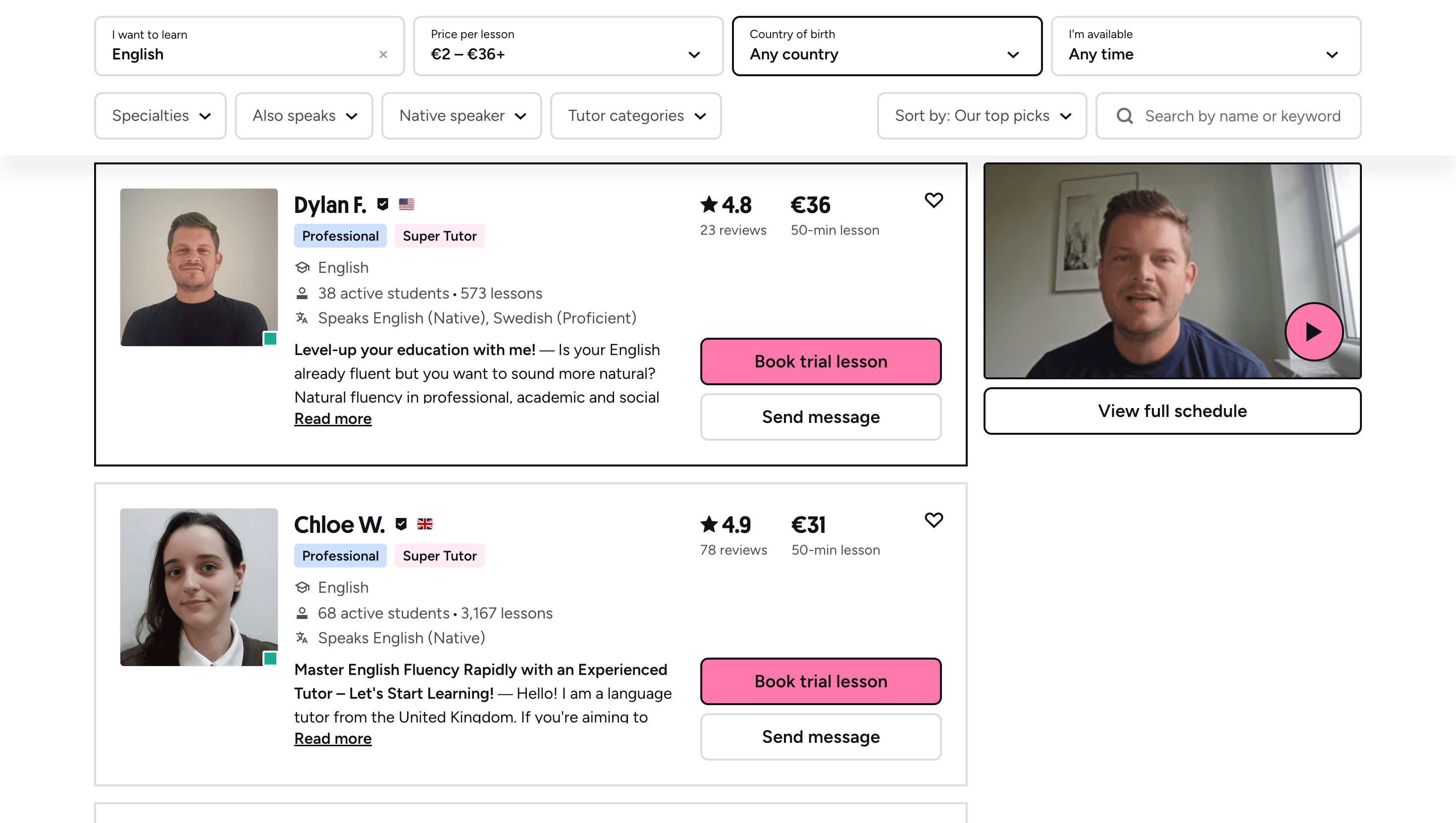
Many learners give up on language learning due to these high costs, missing out on valuable professional and personal opportunities.
That’s why we created Kylian: to make language learning accessible to everyone and help people master a foreign language without breaking the bank.
To get started, just tell Kylian which language you want to learn and what your native language is
Tired of teachers who don’t understand your specific struggles as a French speaker? Kylian’s advantage lies in its ability to teach any language using your native tongue as the foundation.
Unlike generic apps that offer the same content to everyone, Kylian explains concepts in your native language (French) and switches to the target language when necessary—perfectly adapting to your level and needs.

This personalization removes the frustration and confusion that are so common in traditional language learning.
Choose a specific topic you want to learn
Frustrated by language lessons that never cover exactly what you need? Kylian can teach you any aspect of a language—from pronunciation to advanced grammar—by focusing on your specific goals.
Avoid vague requests like “How can I improve my accent?” and be precise: “How do I pronounce the R like a native English speaker?” or “How do I conjugate the verb ‘to be’ in the present tense?”

With Kylian, you’ll never again pay for irrelevant content or feel embarrassed asking “too basic” questions to a teacher. Your learning plan is entirely personalized.
Once you’ve chosen your topic, just hit the “Generate a Lesson” button, and within seconds, you’ll get a lesson designed exclusively for you.
Join the room to begin your lesson
The session feels like a one-on-one language class with a human tutor—but without the high price or time constraints.
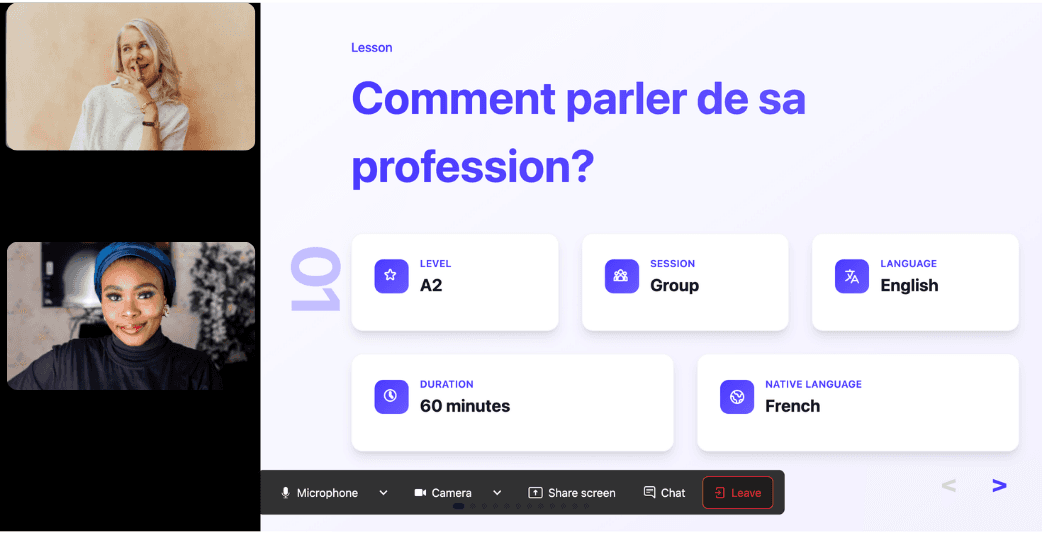
In a 25-minute lesson, Kylian teaches exactly what you need to know about your chosen topic: the nuances that textbooks never explain, key cultural differences between French and your target language, grammar rules, and much more.
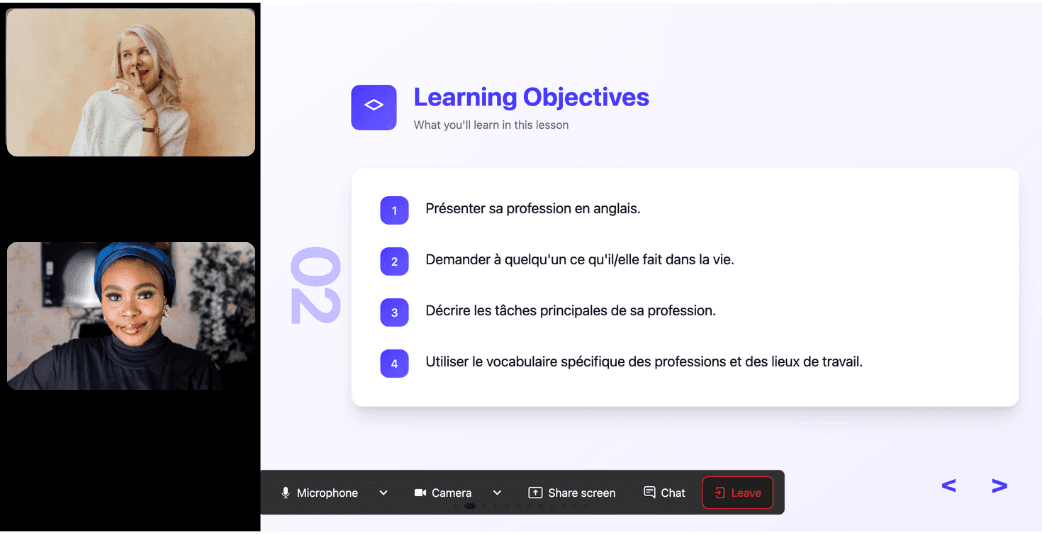
Ever felt frustrated trying to keep up with a native-speaking teacher, or embarrassed to ask for something to be repeated? With Kylian, that problem disappears. It switches intelligently between French and the target language depending on your level, helping you understand every concept at your own pace.
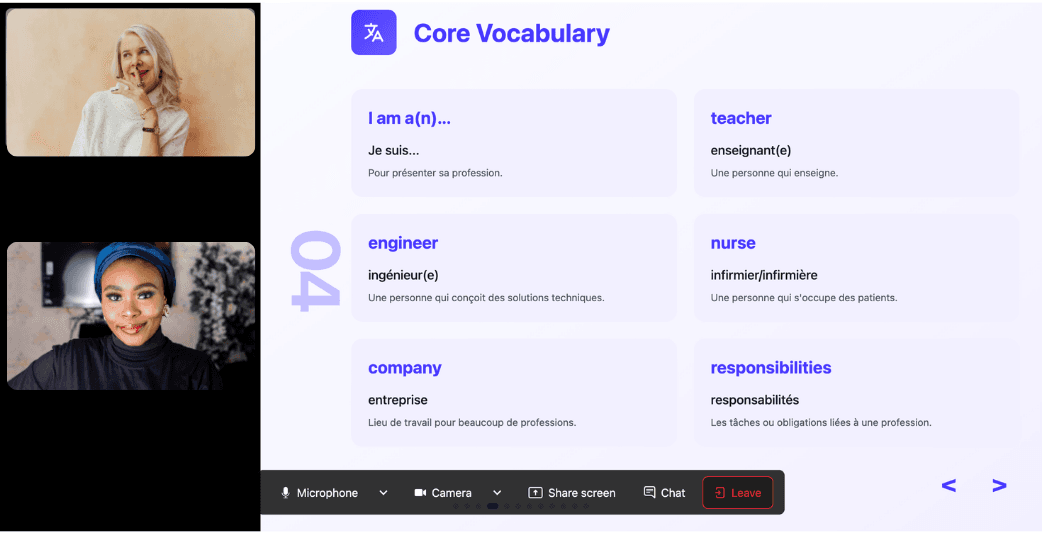
During the lesson, Kylian uses role-plays, real-life examples, and adapts to your learning style. Didn’t understand something? No problem—you can pause Kylian anytime to ask for clarification, without fear of being judged.

Ask all the questions you want, repeat sections if needed, and customize your learning experience in ways traditional teachers and generic apps simply can’t match.

With 24/7 access at a fraction of the cost of private lessons, Kylian removes all the barriers that have kept you from mastering the language you’ve always wanted to learn.
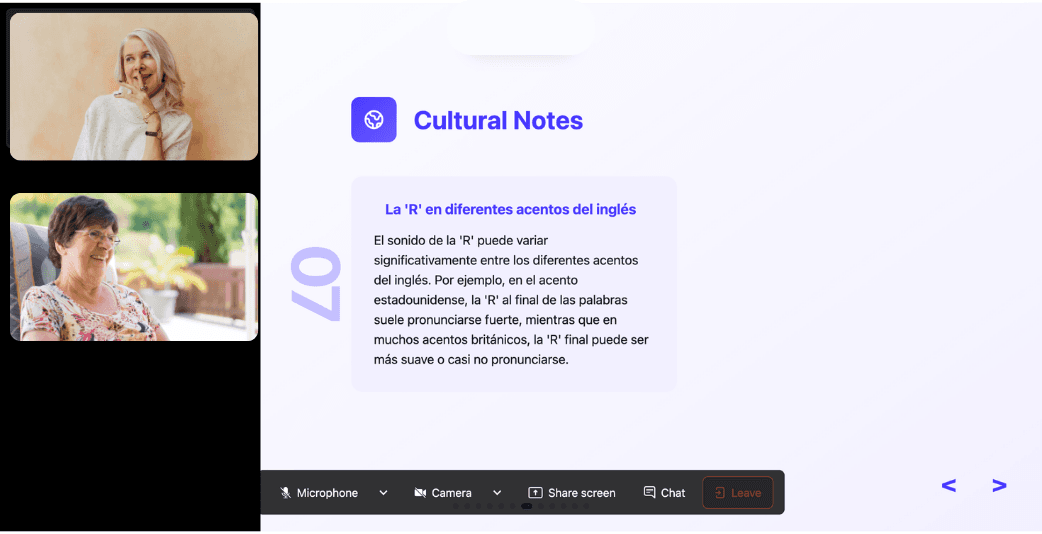
Similar Content You Might Want To Read

Abbreviation for Pieces in English Chess Notation
Chess notation serves as the universal language that connects players across borders and skill levels. The abbreviation for pieces in English represents a fundamental aspect of chess literacy, enabling players to record, analyze, and communicate games effectively. Understanding these abbreviated symbols unlocks access to centuries of chess knowledge and facilitates participation in the global chess community.

Tagalog Pronunciation Guide: Master Filipino Speaking Skills
Picture this scenario: You confidently approach a local vendor in Manila, ready to bargain for fresh mangoes in Tagalog. Instead of the friendly negotiation you expected, you're met with puzzled stares and barely concealed amusement. The culprit? You've just asked for "manggang mata" (eye mango) instead of "manggang hinog" (ripe mango) due to a subtle mispronunciation that completely altered your intended meaning. This experience, while embarrassing, highlights a fundamental truth about Tagalog: pronunciation precision directly correlates with communication success. Unlike languages where mispronunciation might result in mild confusion, Tagalog's tonal and stress-dependent nature means small errors create significant meaning gaps. The stakes matter more now than ever. With over 100 million Tagalog speakers globally and the Philippines emerging as a key player in Southeast Asian commerce, accurate pronunciation has evolved from cultural courtesy to professional necessity. Whether you're building business relationships, connecting with Filipino communities, or simply showing respect for the culture, mastering these pronunciation fundamentals determines your communication effectiveness. This guide dissects the critical elements that separate competent Tagalog speakers from those who struggle with basic comprehension issues. We'll examine the phonetic architecture, stress mechanics, and systematic approaches that create authentic Filipino speech patterns.

Main Spanish Phrases to Know Before Visiting Barcelona
Barcelona demands more than tourist enthusiasm—it requires linguistic preparation. While Catalonia speaks Catalan as its primary language, Spanish remains the universal bridge for meaningful interactions. The city's tourism infrastructure operates predominantly in Spanish, making basic fluency not just helpful but essential for authentic experiences. The mathematics of language necessity become clear when examining Barcelona's demographic reality. According to the Instituto Nacional de Estadística, 99.9% of Barcelona residents speak Spanish, compared to 74.6% who speak Catalan. This linguistic landscape creates a clear strategic advantage for travelers who invest time in Spanish preparation rather than relying on English communication. Most critically, Barcelona's service industry—restaurants, transportation, local shops—operates with limited English proficiency among front-line workers. This reality transforms basic Spanish from a cultural courtesy into a practical necessity for accessing the city's authentic offerings beyond tourist-centric establishments.

How to Learn Portuguese: Practical Tips for Beginners
Portuguese stands as the sixth most spoken language globally, with over 260 million native speakers across four continents. Yet most language learners gravitate toward Spanish, French, or German, overlooking this linguistic powerhouse that opens doors to vibrant economies in Brazil, Portugal, Angola, and Mozambique. The question isn't whether Portuguese deserves your attention—it's how to master it efficiently without falling into the common traps that derail 80% of language learners within their first six months. The traditional approach to learning Portuguese fails most beginners because it treats the language as an academic subject rather than a communication tool. This fundamental misunderstanding explains why countless learners spend months memorizing verb conjugations yet struggle to order coffee in São Paulo. The solution lies in strategic learning that prioritizes practical application over theoretical perfection.

Months of the Year in Spanish: The Essential Guide
Learning how to say and write dates in Spanish is fundamental for anyone studying the language. This comprehensive guide covers everything from pronunciation to cultural significance of the months in Spanish. We'll explore proper grammar, historical origins, and provide practical tips to help you master this essential vocabulary.

How to Speak Spanish: 13 Must-Know Tips for Fluency
Have you considered joining the community of over 500 million Spanish speakers worldwide but feel overwhelmed about where to start? Many language learners delay their Spanish journey because they're uncertain about the most effective approach. The good news? Learning Spanish is achievable with the right methods and consistent effort. This comprehensive guide outlines 11 essential strategies to help you speak Spanish confidently and effectively. Whether you're starting from zero or building on basic knowledge, these proven techniques will transform you from a beginner to a fluent Spanish speaker. ¡Vamos!